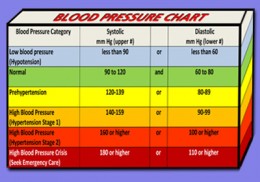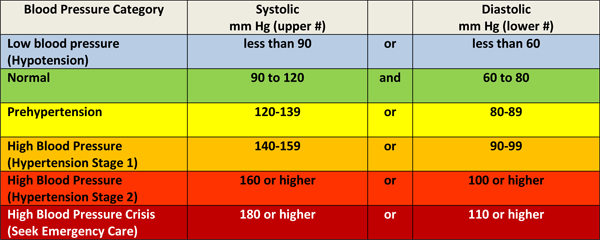Blood Pressure Chart: Understand What Your Blood Pressure Numbers Really Mean
 Would you be able to tell by looking at a blood pressure chart whether you are included in the group of one out of every three American adults with high blood pressure? Is your doctor measuring your blood pressure numbers correctly? High blood pressure contributes to about one in every seven deaths in the United States and causes around half of all deaths from strokes and heart disease according to a report published in the Journal of the American Medical Association.[1] It is especially dangerous because while it greatly increases your chance for having a heart attack or stroke, high blood pressure typically has no warning signs or symptoms.
Would you be able to tell by looking at a blood pressure chart whether you are included in the group of one out of every three American adults with high blood pressure? Is your doctor measuring your blood pressure numbers correctly? High blood pressure contributes to about one in every seven deaths in the United States and causes around half of all deaths from strokes and heart disease according to a report published in the Journal of the American Medical Association.[1] It is especially dangerous because while it greatly increases your chance for having a heart attack or stroke, high blood pressure typically has no warning signs or symptoms.
What is blood pressure?
Your blood pressure is the force of your blood against the walls of your arteries. It is recorded as two blood pressure numbers—the systolic pressure (the force generated as the heart beats or contracts) over the diastolic pressure (the force when the heart is relaxing between beats). The measurement is written with the systolic number on top and the diastolic number on the bottom. For example, blood pressure numbers expressed verbally as “120 over 80” is typically written on a blood pressure chart as 120/80 mmHg (millimeters of mercury).
What is hypertension?
Normal blood pressure rises and falls during the day, but, as you can see on the blood pressure chart (displayed below), normal blood pressure numbers would be less than 120 mmHg systolic and less than 80 mmHg diastolic. If your blood pressure stays elevated to a level of 140/90 mmHg or higher over time, it is considered high and you have hypertension, the medical term for high blood pressure.
Classification of high blood pressure numbers
The most current classification of blood pressure numbers used and accepted throughout the United States is based on a report from an expert panel of physicians and researchers.[2] These values are outlined in the blood pressure chart shown below.
Blood Pressure Chart

Criteria to correctly measure blood pressure numbers at the doctor’s office
The classification outlined in the blood pressure chart above is based on the average of two or more readings taken at each of two or more clinic visits.[1] This means that technically your blood pressure numbers should be measured at least twice at more than one visit before you are given a diagnosis of hypertension. Additional requirements for accurate measurement and diagnosis, according to the expert panel report guidelines include:
- Before measuring your blood pressure numbers, your healthcare practitioner should have made sure you were sitting quietly for at least 5 minutes in a chair (rather than on an exam table), with your feet on the floor, and your arm supported at heart level.
- Caffeine, exercise, and smoking should be avoided for at least 30 minutes prior to measurement.
- An appropriately sized cuff (cuff bladder encircling at least 80 percent of the arm) should be used to ensure accuracy.
- At least two measurements should be made and the average recorded.
Blood pressure measured at doctor’s office often is inaccurate and misleading
Unfortunately, when your blood pressure numbers are measured at the doctor’s office, it is likely that the reading will be inaccurate and misleading, according to the American Heart Association and the American Society of Hypertension.[3] This is due to the fact that the guidelines above are often not followed and also to the so called “white-coat effect”, that is the anxiety many patients feel when their blood pressure numbers are being measured in front of a nurse or doctor. For this reason, if you have been diagnosed with hypertension or prehypertension, based on the current blood pressure chart guidelines, it is highly recommended that you find out your true blood pressure by checking it at home and using the blood pressure chart regularly.
In Part 2 of this article, we discuss in depth the advantages to home blood pressure monitoring over clinic measurements, and in Part 3 you will learn the correct way to accurately measure your true blood pressure numbers at home.
Once you have determined your true, accurate blood pressure, you will know whether or not you need to work on lowering it. Fortunately, lifestyle changes and natural remedies for lowering blood pressure, such as low intensity exercise and magnesium, are extremely effective.
[1] JAMA. 2011;305(15):1531-1534.
[2] JNC-7 Complete Report. Hypertension. 2003;42:1206.
[3] Hypertension. 2008; 52: 10-29.
This post was previously published and has been updated.


 WHITE COAT SYNDROME
WHITE COAT SYNDROME  News Briefs February 2024
News Briefs February 2024  Savor the Sweet Potato
Savor the Sweet Potato 